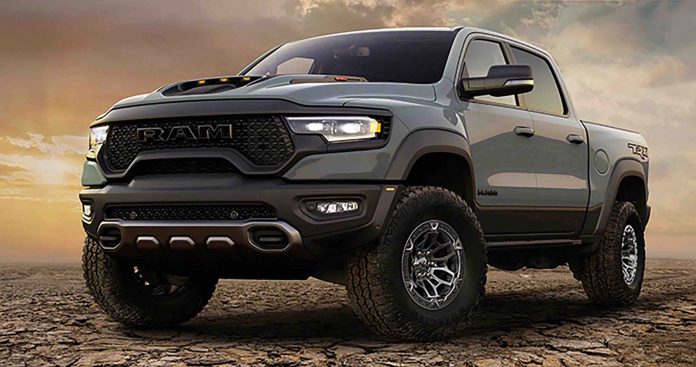It is hard to write about crossover after crossover; about differences in apps and the size of touchscreens. This coming week, there will be something to shout about.
They are sending me one of what may prove to be – truly – the last of the V8 Interceptors. In the form of a half-ton truck. Equipped with the Dodge Challenger/Charger Hellcat’s supercharged 6.2 liter Hemi V8, developing 702 horsepower assaulting the pothole-pocked pavement of Anarchy Lane via 35-inch knobbies and all-terrain tires.
It is the Ram 1500 TRX – and it’s just the tool for dealing with the “new normal.”
It’s just a shame it’s not mine – and also that there’s no clutch button on the shifter to de-couple the blower, in order to conserve gazzuline.
Stay tuned!











Bless Dodge. They have been spitting in the face of all the enviro lap dogging the car industry has been engaged in for years.
How much longer can they get away with it?
But at least they have been pushing back the anti-fun brownshirts.
Drive it to Scottsdale and sell it at a Barrett-Jackson auction, lol.
What really happens:
“Unlike crude oil which is made through distillation, synthetic oil is made through a chemical process called the Fischer-Tropsch process. It was started by Germany in the WWII when the country had very limited access to crude oil and had to look for an alternative option for oil.
It’s generally just that synthetic oil ends up reduced to its basic molecules once motor oil is distilled and purified. And it’s during this process that lots of impurities are extracted from conventional oils so that individual molecules get customized to work with both today’s sophisticated vehicles and machinery. This is also how and why synthetic oils end up performing better in high and low temperatures. They are also formulated by adding higher performing additives.
Synthetic oil is made in the lab, which is why different manufacturers and brands use different approaches to produce their respective oil. While no manufacturer will divulge the secrets or methods they use to make synthetic oil, here’s some basic information about the oil manufacture process.
The process starts using ordinary petroleum as the main feedstock with additional raw materials like carbon dioxide, carbon monoxide and methane. These raw materials are injected and blended with artificial chemical compounds that are absent in natural crude oil to create uniformly sized and weighed oil molecules.
These highly modified molecules are equal in term of size and shape and help the oil work better as lubricants. Besides, additional atoms are also added to it to make the molecules function better. For example, adding zinc- an anti-wear agent to the oil, along with other chemicals help neutralize acids that are created during the combustion of gasoline or diesel fuel.”
Synthetic Oil
I really appreciate what Dodge Jeep are bringing to market this year – Check out the new V8 Wrangler as well.
https://www.jeep.com/wrangler/rubicon-392.html?sid=913821&KWNM=jeep+wrangler+392&KWID=43700058622795195&TR=1&channel=paidsearch&gclid=e203b0c3bd701b814630d0a25b598fdd&gclsrc=3p.ds&msclkid=e203b0c3bd701b814630d0a25b598fdd
I think Chrysler Jeep Dodge Ram are the only brands that advertise their engines anymore. They actually show a picture of the engine there. And the engine is even meant to be looked at, no engine cover. The only brands attempting to appeal to masculinity. I wish them the best of luck.
‘It is the Ram 1500 TRX – and it’s just the tool for dealing with the “new normal.”’ — EP
Its mean, mean dog face — definitely exhibiting some German Shepherd ancestry — cries out for a couple of AR15s concealed behind the blackout grille.
Controlled, of course, by an ominous red push button, not some sissy-ass screen menu.
New Normal dead ahead — make it go away, daddy!